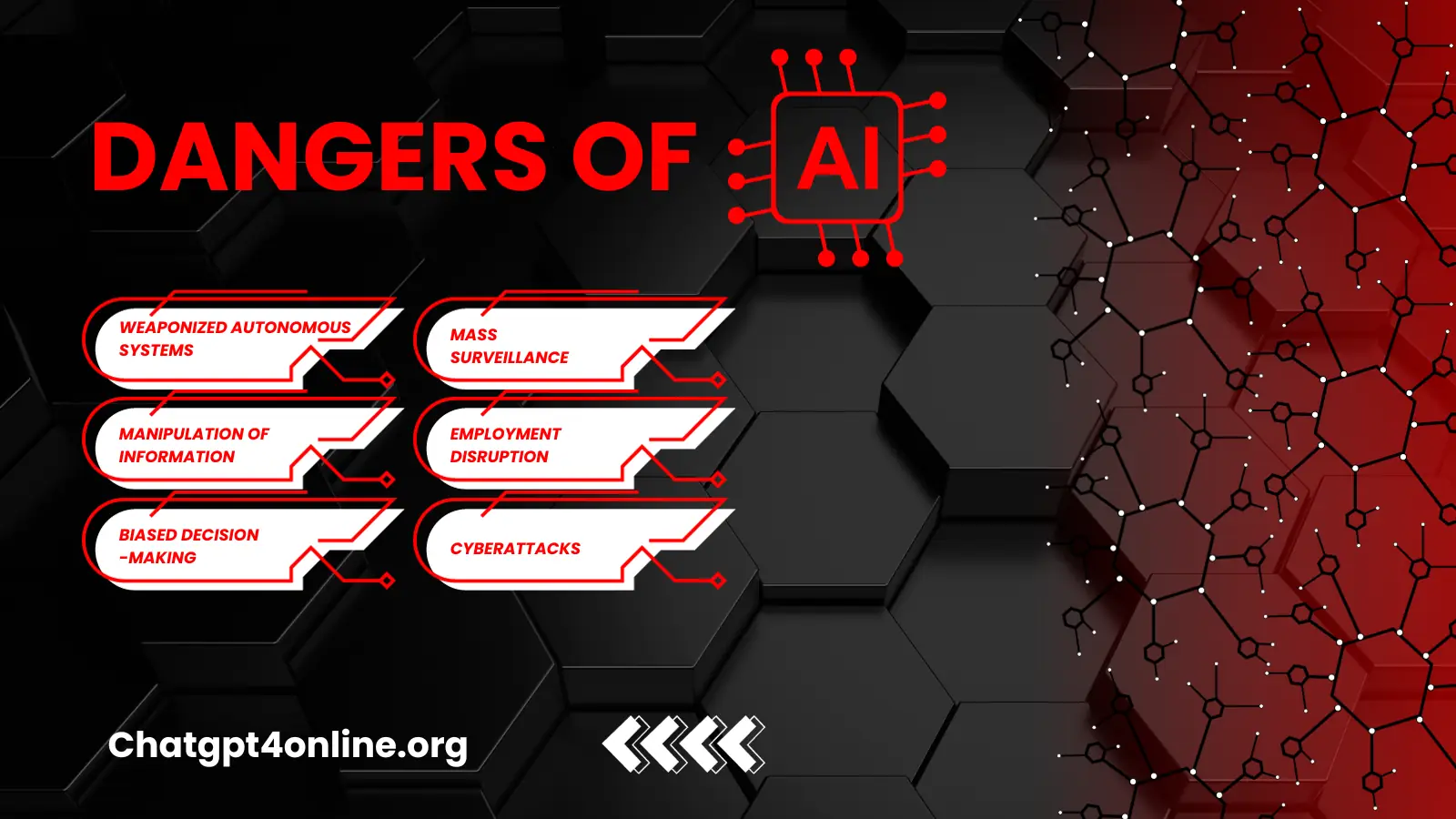Dangers of AI: Will AI Take Over the World?
Discover the potential dangers of AI and the ways to mitigate them…

The notion of artificial intelligence conquering the world seems to be more of a science fiction concept than a plausible reality. However, the rapid development in the field of artificial intelligence has made experts think about the dangers of AI or whether it will take over the world if it continues to develop to such an extent that it can be used harmfully against humanity.
AI is a tool created and controlled by humans to assist with various tasks and make our lives more efficient but it can be misused by humans. At this stage of artificial intelligence development, we don’t witness any such dangers of AI that can make us believe that it’s going to take over the world. However, there’s much possibility of the abuse of AI by many sectors of society. We’ll explore these possibilities and what measures can be taken to avoid them.
Will AI Take Over the World?
AI systems, including the most advanced ones like GPT-4, have limitations and operate under strict limitations set by their programming and data. They lack consciousness, self-awareness, and intentions. They perform tasks based on patterns and information in their training data. However, the concerns about the dangers of AI and AI taking over the world typically revolve around a few different scenarios:
Super-intelligent AI
The idea that we might one day create an AI system that becomes vastly more intelligent than humans and could potentially act in ways that are contrary to human interests. This is a theoretical concern and a topic of debate among AI researchers.
Misaligned Goals
There’s a concern that even without superintelligence, AI systems could be developed with goals that are misaligned with human values, leading to unintended harmful consequences. Ensuring AI systems have aligned goals is a significant challenge.
Security Risks
Malicious use of AI could pose threats, such as using AI for cyberattacks, deep fakes, or autonomous weapons. These concerns require robust security measures and ethical guidelines.
Narrow AI Vs. General AI
AI is a tool that can be used for both beneficial and harmful purposes, depending on how it’s employed by humans. It’s essential to distinguish between narrow or weak AI designed for specific tasks and general or strong AI possessing human-like intelligence and consciousness. We have not yet achieved the latter.
Narrow AI systems, such as voice assistants like Siri or recommendation algorithms used by companies like Netflix or Amazon, excel in specific domains but cannot transcend their designated functions. They operate within the bounds of their programming and data inputs.
Social Impact of AI
Before exploring the dangers of AI, it’s better to understand first how the narrow AI is safe for humanity. Some real-life examples help us to understand the potential impact of Narrow AI on our society.
Autonomous Vehicles
Self-driving cars use AI for navigation and decision-making. However, they are still controlled by humans and designed to prioritize safety. The widespread adoption of autonomous vehicles will depend on regulatory approval and societal acceptance, rather than an AI-led conquest.
Medical Diagnosis
AI has shown promise in assisting doctors with diagnosing diseases like cancer. However, it complements human expertise rather than replacing it. Doctors use AI as a tool to analyze vast amounts of medical data more efficiently.
Finance
AI is employed in the financial industry for trading algorithms and fraud detection. While it can optimize trading strategies, it’s not autonomously making decisions to conquer the financial markets.
Language Translation
AI-powered translation services like Google Translate are useful tools, but they are not taking over languages or cultures. They assist people in breaking down language barriers.
So, the mentioned social impacts of AI that we’re experiencing are not harmful to humanity rather it proves that AI helps humans to work more efficiently. However, the issues concerning bias, job displacement, and privacy revolve around how we choose to implement and regulate AI, rather than AI itself having ambitions of world domination.
Dangers of AI
Along with having a lot of benefits for humanity, artificial intelligence has the potential to be exploited in various ways by the military, politicians, and giant tech companies in the future. While AI technologies offer numerous benefits, their misuse can have significant ethical, social, and political implications. Here are some examples of how AI could be exploited:
Weaponized Autonomous Systems
One of many dangers of AI is a weaponized autonomous system. Military organizations could use AI to develop autonomous weapon systems that make decisions about when and whom to target without human intervention. These lethal AI systems, often referred to as “killer robots,” raise concerns about accountability and the potential for unintended harm.
For example, a military deploys AI-driven drones that can identify and engage targets independently, potentially leading to indiscriminate attacks and civilian casualties.
Mass Surveillance
Mass surveillance is also a significant danger of AI that can’t be ignored. Governments and tech companies may leverage AI-powered surveillance systems to monitor citizens on a massive scale, infringing on privacy rights and civil liberties. Facial recognition technology, in particular, poses significant risks when used without appropriate oversight.
For example, a government employs AI-powered cameras to track the movements and activities of its citizens, leading to a pervasive surveillance state.
Manipulation of Information
Another very powerful and risky factor of Artificial Intelligence is the manipulation of information. Politicians and tech companies could exploit AI algorithms to spread disinformation, manipulate public opinion, and influence elections. AI-powered deep fakes and social media algorithms can be used to create and amplify misleading or false narratives.
For instance, a political campaign employs AI-generated deep fake videos to depict opponents making inflammatory statements, sowing confusion and mistrust among voters.
Employment Disruption
Employment disruption is the dangerous outcome of AI that we’ve started to face but it can go beyond the limits in the future. Giant tech companies may deploy AI systems that automate jobs on a massive scale, leading to widespread job displacement. While AI can boost efficiency, the economic and social consequences of job loss need careful consideration.
For example, a tech company replaces its human customer service representatives with AI chatbots, resulting in significant job losses and economic instability in the region.
Biased Decision-Making
Biased decision-making is a danger of AI that can affect us enormously. AI algorithms can inherit biases present in their training data, which can lead to discriminatory outcomes in areas like lending, hiring, and criminal justice. Exploiting these biases for personal or corporate gain can exacerbate existing inequalities.
For instance, a financial institution uses an AI-based credit scoring system that discriminates against minority groups, leading to unfair lending practices.
Cyberattacks
Another danger of AI is that it can be exploited by hackers for cyberattacks. AI can enhance the effectiveness of cyberattacks, including malware that can adapt and evolve in response to security measures. This could lead to more sophisticated and damaging cyber threats.
For example, a malicious actor employs AI-driven malware that learns and evolves its tactics to bypass cybersecurity defences, causing extensive damage to critical infrastructure.
How to Mitigate the Dangers of AI
To mitigate the potential negative consequences of artificial intelligence, it is crucial to establish robust regulatory frameworks, ethical guidelines, and international agreements that govern AI use. Responsible development, deployment, and oversight of AI technologies are essential to ensure that they are used for the benefit of society rather than exploited for harm. Here are some measures that can be taken to address these challenges:
Regulation and Accountability
Governments should enact and enforce regulations that govern the use of AI in military applications, surveillance, and information dissemination. Clear accountability mechanisms should be in place to hold individuals and organizations responsible for AI-related misconduct.
Ethical AI Development
Tech companies and researchers should prioritize ethical considerations when developing AI systems. This includes addressing bias in algorithms, ensuring transparency in AI decision-making, and conducting thorough impact assessments.
Oversight and Transparency
Establish independent bodies and agencies responsible for overseeing AI applications in sensitive areas like defence and surveillance. Transparency in AI systems’ design, decision-making processes, and data sources should be mandated.
International Cooperation
Global cooperation is crucial to address AI-related challenges, as AI knows no borders. International agreements and conventions can help set common standards and norms for the responsible use of AI in military and political contexts.
Public Awareness and Education
Public awareness campaigns and education efforts can help individuals recognize AI-driven misinformation, understand the implications of AI in society, and advocate for responsible AI use.
Ethical AI Education
Training and education programs should be established for AI developers, policymakers, and military personnel to promote ethical AI practices and responsible decision-making.
Red Teaming and Ethical Hacking
Organizations, including governments and tech companies, can proactively test their AI systems’ vulnerabilities through red teaming and ethical hacking exercises to identify and address potential risks.
Community Engagement
Governments and tech companies should engage with communities and stakeholders affected by AI applications to gather input, address concerns, and ensure that AI benefits are distributed equitably.
Final Thoughts
While artificial intelligence tools like ChatGPT online offer incredible potential for positive change, AI also present risks when exploited by the military, politicians, and tech companies. Proactive measures are necessary to mitigate these risks or dangers of AI, ensure responsible AI development, and safeguard society from potential harm. Collaborative efforts among governments, organizations, and the public are crucial to strike a balance between innovation and ethical use of AI technologies.

Albert Haley
Albert Haley, the enthusiastic author and visionary behind ChatGPT4Online, is deeply fueled by his love for everything related to artificial intelligence (AI). Possessing a unique talent for simplifying intricate AI concepts, he is devoted to helping readers of varying expertise levels, whether they are newcomers or seasoned professionals, in navigating the fascinating realm of AI. Albert ensures that readers consistently have access to the latest and most pertinent AI updates, tools, and valuable insights. His commitment to delivering exceptional quality, precise information, and crystal-clear explanations sets his blogs apart, establishing them as a dependable and go-to resource for anyone keen on harnessing the potential of AI. Author Bio

